A Mini-DXpedition to P29 Land
by
Jack Carter, KC6WYX
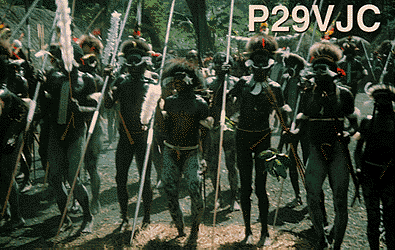
Dani Warriors, village in Baliem Valley of Iran Jaya
When a friend invited me to join his group on a trip to New Guinea in 1995, I quickly saw the possibilities of operating DX as a P29 station. While hunting DX contacts for the past 3 years, I had always envied the lucky operators on the other end. The possibility of calling CQ from a Pacific island with an exotic call sign was more than I could resist, not to mention the possibility of seeing areas the South Pacific, which had not been viewed by outsiders until early in this century, and the scenes of heavy fighting in WW2. With info from the ARRL, I wrote to Papua New Guinea and applied for a visitors license (P29VJC) and started reading everything about New Guinea, which I could get my hands on. I also wrote to all the P29 Hams which I had previously contacted, asking for any useful information.
The trip, I later learned, was to be a cruise on the M/S Pearl. The ship was to depart Cairns (pronounced Cans), Australia on 27 July with stops at Madang and Wewak in PNG, Jaya Pura in Indonesia, Lae and Samarai Island in PNG, then returning to Cairns. It sounded great to me. All these places recked with history and I was ready. Jaya Pura, previously know as Hollandia, Dutch New Guinea, was the site of General MacArthur's headquarters after the enemy was neutralized in New Guinea. It was also the jumping off place for the invasion of the Philippines.
I received a letter from Ron Piovesan, P29DY, with lots of information, including the name and location of a missionary group in Madang who operate an amateur radio station. This was to prove to be a critical in making my DXpedition a success. With a borrowed Kenwood TS50, two 17.2ah gel cells, and a 20m dipole, the XYL and I flew out of LAX for Cairns via Sydney. About 24 hours later we were sailing for Madang, PNG from Cairns.

M/S Pearl at anchor off Samarai I. China Strait, PNG
The weather on the Coral Sea was dominated by an unusual high southwest of Australia, which brought Antarctic wind and rough riding for the ship. In these same waters in May of 1942, Allied naval forces turned back an enemy invasion task force headed for Port Moresby. Thus the Battle of the Coral Sea stopped a thrust which surely would have been followed by an invasion of Australia. Things calmed down when we reached the China Strait, the historical route around the east end of New Guinea. As dawn broke on the 28th we were cruising the north coast of PNG on the Solomon Sea. The lush peaceful green coast of New Guinea gave no hint of the desperate bloody fighting which swept this island during WW2. The Victory at Sea video volume on it was titled, "Melanesian Nightmare". It was great to be on a large ship again. I visited the bridge when ever it was open to the passengers. Going north toward the eastern entrance of the Vitiaz Strait, between New Guinea and New Britain, we passed Cape Cretin on the afternoon of the 29th. This is near Finschhafen, which was the first European settlement on the north coast. In 1885 an unsuccessful attempt was made to colonize the area by Germans. The area later became a large base for the Allies after they ejected the enemy from the north coast of New Guinea. As dawn broke on the 30th, we were approaching Madang.
As soon as passengers could leave the ship, I headed into Madang. It is a small resort town and is said to be the prettiest town in PNG. I can believe it. The entry of the harbor is a vision of South Pacific loveliness. As I walked into town, I spotted the local police station and inquired as to the location of the Pioneer Bible Translators (a missionary group with active Hams). They offered to take me there, so the 4 Constables and I piled into their utility vehicle and drove over to a building sprouting a trapped Yagi.
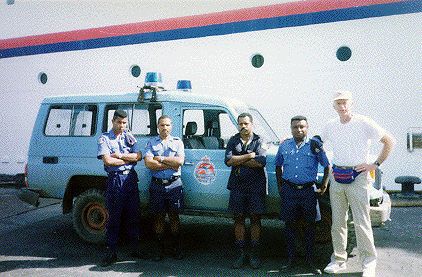
The Constables, P29VJC & M/S Pearl, Madang, PNG
At Pioneer Bible Translators, I met David Parish (P29WY) and XYL Alice(P29AP). They graciously offered me the use of their facility and antenna, apologizing because they didn't have a transceiver. The Constables and I made a quick trip to the ship to get the TS50 and batteries and returned me to PBT. In less than 1 1/2 hours after docking, I was receiving a familiar voice, John (KF�UI), 57 on the 14.247 DX net. When John gave me a 56, my fears of having traveled 8000mi from home to get skunked by poor propagation, were gone. Within an hour, I worked the US west coast, midwest, and east coast, British Virgin Islands, Grenada, and Contradora I. in Panama. When the net closed down propagation was still strong, so I kept the frequency. It also didn't hurt to be sitting on IOTA OC-034 during the IOTA contest. When things slowed up a bit, I QSYed to 14.204 and business picked up again. The ship was sailing at 6pm and passengers were to be on board by 5pm. At 5:14pm (0714Z), I worked my last contact from Madang and went QRT with 146 contacts, 26 states and 12 countries in my P29VJC log. Sandra (P29SZZ) from PBT offered me a ride back to the ship, so I didn't have to run the mile with 40 lb of gear. It had been a Great! day for a guy who was a Novice 3 years ago.
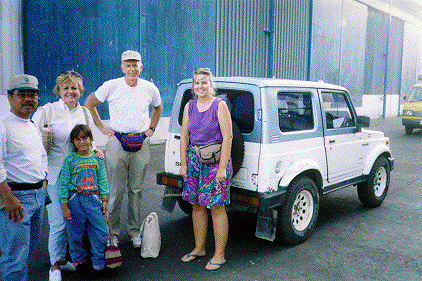
Reboarding the Pearl; WL6RA, XYL & 2nd Harmonic, P29VJC & P29SZZ, Madang, PNG
After a day at sea we entered Wewak, to greeted by a large group of native dancers from a local tribe performing on the pier.
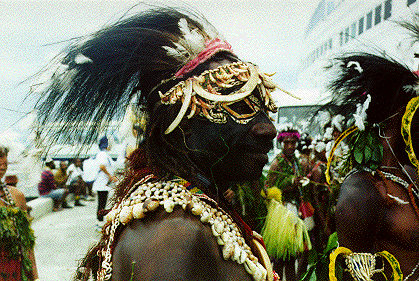
Male Dancer, Wewak, PNG
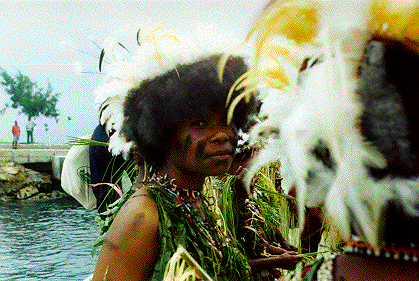
Lady Dancer, Wewak, PNG
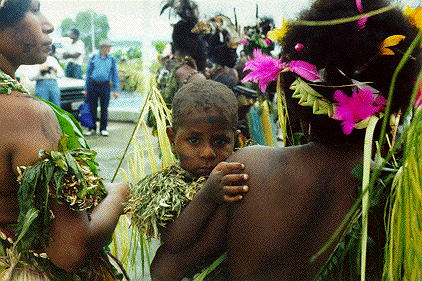
Lady Dancer with Child, Wewak, PNG
We spent the first day touring Wewak and absorbing the local color. On the second day in Wewak, we traveled to Angoram by van for a tour of the Sepik River area in log canoes powered by outboards. The Sepik was the main route into the interior of New Guinea for years and remains populated with interesting tribal villages. Curiously, the pidgin (main native language) word for outboard motor is "Johnson" and a serious marketing problem for the Kawasaki salesman. We boarded our canoes and started up the Sepik under a wide blue sky, moving toward a world little changed in centuries.
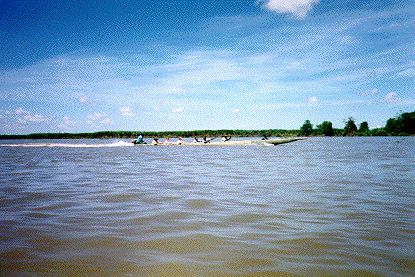
Long dugout canoe with "Johnson" moves up river, Sepik River, PNG
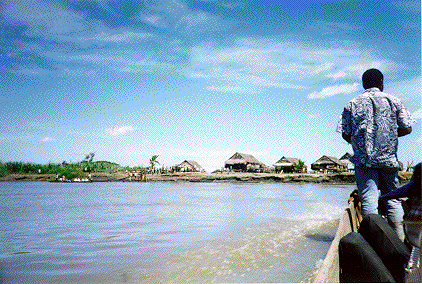
River Scene, Sepik River, PNG

River Village, Sepik River, PNG
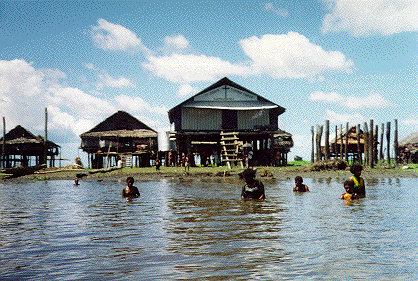
St Joseph Catholic Church, Kambaramba, Sepik River, PNG
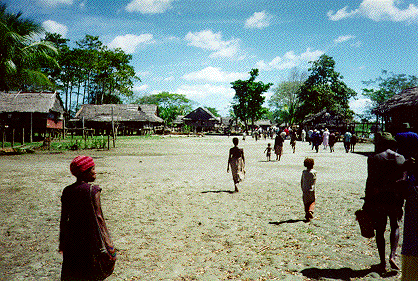
Village Scene, Kambaramba, Sepik River, PNG
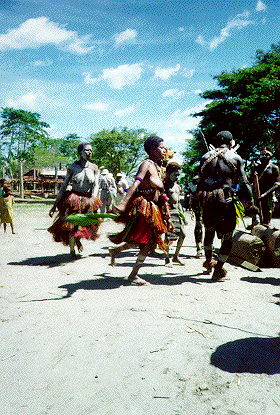
Dancers, Kambaramba, Sepik River, PNG
Leaving Wewak that evening, the ship cruised overnight to Jaya Pura (Hollandia), and was again greeted by a native dancing group. Here I had the opportunity to fly into the interior highlands
to visit the very primitive Dani people of the Baliem valley. These stone age warrior farmers continue to pursue life as they have for thousands of years. Although they are content to ignore clothing, automobiles and airplanes, they have added tobacco to their life style.
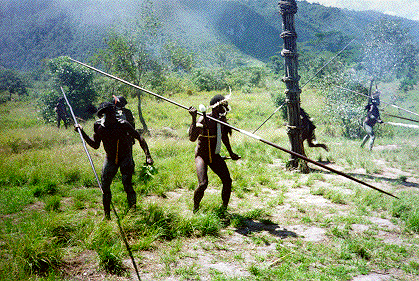
Dani Tribesmen at "War", near Wamena, in Baliem Valley,Iran Jara
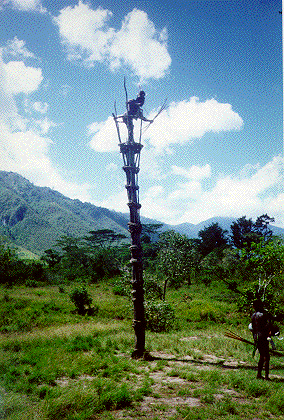
Dani Lookout Watches for Pig Thieves, in Baliem Valley,Iran Jara
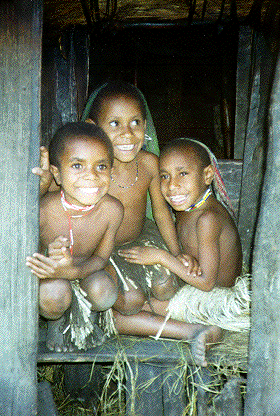
Happiness and Curiosity Beam from the Faces of Dani Childern
We flew back to Jaya Pura and that evening we sailed east into the Bismarck Sea (scene of another WW2 Air-Sea battle), bound for Lae. Civilization was thrust upon Lae big time when gold was discovered near here in 1921. Amelia Earhart took off from Lae on her last and ill fated flight, in July 1937. Lae, while in enemy hands, was heavily bombed by the Allies and recaptured on 16 September 1943. Since then Lae has developed into a thriving port city, with problems familiar to many modern urban areas.
By this time I began to suffer from DX withdrawal pains, so I made plans to operate from our next stop, Samarai Island (IOTA OC-153). In route the ship made a passage through Milne Bay. We passed by Ahloma, where in August 1942, the Australians gave the invading enemy their first land defeat of the war . At Samarai, the ship had to anchor off the island, so we went in on the ships motor launch. Samarai was once the capital of Milne Bay Province and the jewel of New Guinea. In half an hour you can walk around the island which now peacefully sleeps, dreams of it's past and hopes for the future. A few minutes after arrival, I was introduced to Wallace Andrew, a local "Big Man". I explained that I wanted to operate my Ham station. He lead me to a community building and helped get my dipole up.
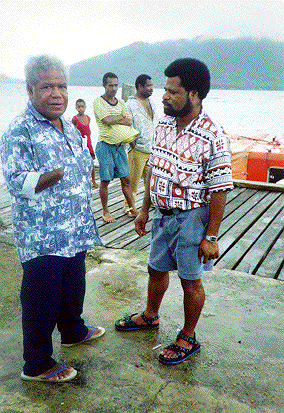
Wallace Andrew, a local "Big Man" & Jim Yomapisi of PNG Tourism, Samarai Island
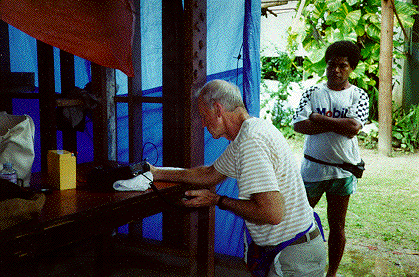
P29VJC "on his knees" to get DX, a Samarai Islander Observes
I worked some Australian stations, but there were only a few weak signals coming from the US, and they were not answering. After a couple hours, I packed up the gear and caught the last launch back to the ship. In an hour, we sailed for Cairns. The Antarctic winds were still whipping up the Coral Sea, only much worse. There were quite a few empty chairs in the dinning room that day. Back in Cairns, we had time for a day of sightseeing and another for a trip to the Great Barrier Reef. We flew out of Cairns at 10am on Aug 10th. Strangely, we flew around the world to the east, the Sun went west around the world and both arrived in Los Angeles at 10am on Aug 10th. Hi Hi. For those who would know more, I recommend, "Papua New Guinea", Wheeler and Murray, Lonely Planet and "History of U.S. Naval Operations in World War II, Volume VI", Morrison, Little & Brown. I am still under New Guinea's spell and I am keeping my Papua New Guinea license renewed.
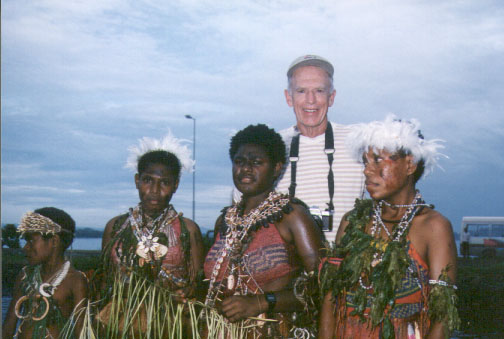
Dancers with P29VJC, Wewak, PNG
Click here to return to -------.



















